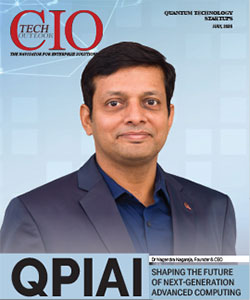Maximizing Business Insight with Big Data Analytics
Vinit Dixit, Head IT, LipiData Systems Ltd
 Vinit is an IT professional with a B.E. in Electronics and Telecommunication from B.N. College of Engineering and a PG in Big Data Engineering from BITS Pilani. A seasoned Chief Information Officer, he excels in Big Data technologies, Oracle cloud infrastructure, Business Analytics, Mobile Applications, Project Implementation, and Business Process Re-engineering.
Vinit is an IT professional with a B.E. in Electronics and Telecommunication from B.N. College of Engineering and a PG in Big Data Engineering from BITS Pilani. A seasoned Chief Information Officer, he excels in Big Data technologies, Oracle cloud infrastructure, Business Analytics, Mobile Applications, Project Implementation, and Business Process Re-engineering.It was the mid-80s when Apple Inc and Microsoft Corp came up with their revolutionary personal computer designs. Since then the power of computing and the ability to store data for a computer, system has undergone major transformations. The designs of computers we had in the 80s were quite different from the design of computers we had today.
Well, business leaders and thought leaders always keep thinking about solving or simplifying the complex problems of businesses. These thought leaders inspire the software developer community to think differently to design much better solutions. Moreover, these much better solutions are always having an appetite to consume more computing resources. Earlier the solutions designed to store the final output or the final transaction with optimized storage were considered efficient solutions. These were typical OLTP solutions. However, as the availability of storage and computing became cheap and handy we started storing associated data also. For example, these days in addition to storing core transactions it is very common to store the demographic data of the application user. When we use any social media application or banking application, it stores the location details from where we have accessed the application, network details over which we have accessed the application, and device details from which we have accessed the application.
Over the period with the advent of the NoSQL database, big data engineering, cloud computing, and high-speed internet the solution architects have started thinking very differently for application designs. The applications of the current times enable us to store structured transactional data as well as associated unstructured data. The unstructured data like images geocodes, logs, emails, feeds, and web page content are important and integral parts of our core transactions and bring new dimensions to the data analyses.
Whether we use it or not our current business ecosystems are continuously generating enormous data. In contrast with OLAP, Big data does not speak for itself; rather you need to make it to speak.
The key message being conveyed is that strategists and business leaders must define their business objectives targeted for addressing through big data analyses.Setting up business objectives for data analyses defines a road map for solution architects. Solution architects and big data engineers ensure that the required data or datasets are being captured and will be made available for analysis. Since the data generated is so enormous, one needs specific tools and technologies to transport and store this data. Data is moved and stored using specific tools and techniques based on the time of analysis i.e. whether data needs to be analyzed on a real-time basis or near real-time basis or on-demand. Sometimes a stream of data needs to be analyzed on real-time basis to meet some business objective and subsequently, the same data stream can be used afterwards for some different business objective. For example, stock price and trading volume data can be analyzed on real-time basis for predicting stock price movement in the next ‘time window’, whereas the same data can be analyzed over a window of days, months or year to predict long term trends, peer performance comparisons, industrial outlook etc. Data engineers and solution architects need to know these small but important aspects before setting up the ecosystem for data analyses within any organization. Sometimes the outcome of the analysis also has an expiry, i.e if the insight has been made available to business leaders well on time then it has a great impact on actions but if they fail to get the insight well on time then it is of no use. The solution architects and data engineers have to ensure that the tools and technologies in place are capable enough to address the business needs and the solution is resilient enough to handle any sort of exceptional situation as well as unprecedented scenario. It could be a sudden increase in data coming in or misleading / garbage data coming in or non-availability of data from the sources or NW outage or server outage or a human error that leads to the wrong outcome.
Once an efficient big data analysis ecosystem is in place at any organization, it needs to gain reliability among the business leaders. Business leaders should extensively examine the outcomes of analyses in all possible scenarios in a scientific manner. Exactitude is the only key to deciding the depth of business insights getting into action for any organization. A pharma company that plans to launch new medicine for a better cure of a disease will use data insights, which are coming out of enormous data from R&D, lab trials, and field trials, Or an airline company deciding fares of different routes on current as well as future dates, they all need business insights which are always accurate and meaningful without fail or zero false positive.
Personally, these days we all use weather forecast data and vehicle traffic data to plan our day and we all are relying on these insights without a doubt. It has become possible because it is available whenever you want it and it delivers the required insight accurately every time. The same stands true for businesses.
Well-captured and well-curated data footprints being stored using best-fit tools & technologies and analyzed using appropriate techniques/algorithms bring reliable and highly available business insights, which empower organizations to make data-driven decisions.




